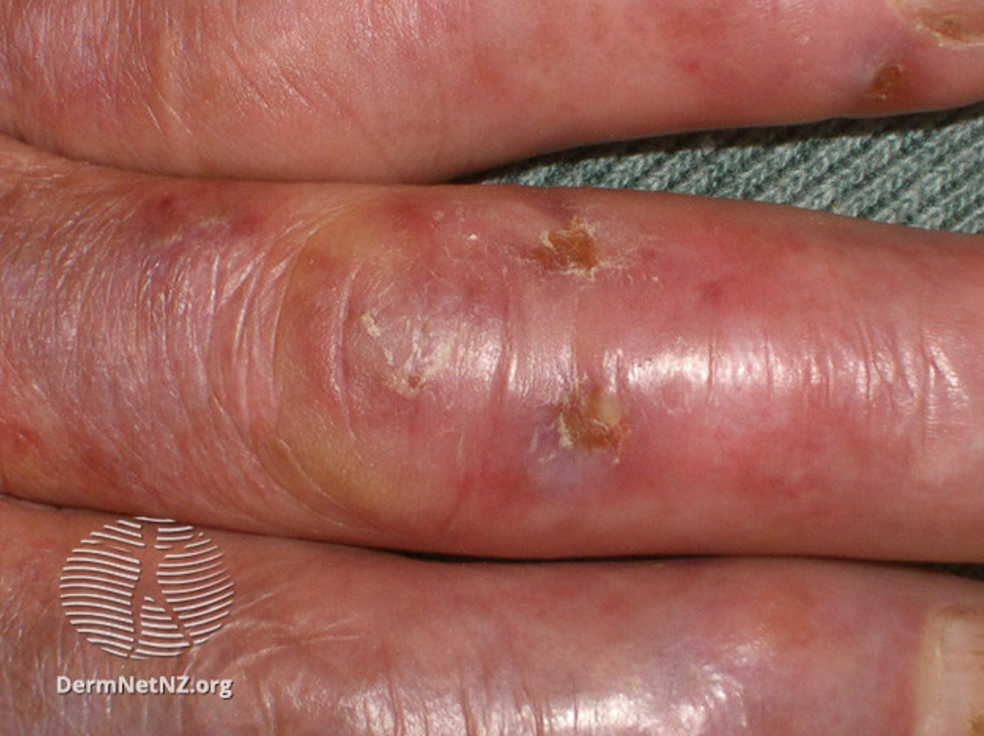chilblains
Chilblains, also known as perniosis, are areas of the skin (seen as patches) which are small and itchy. They appear after exposure to cold, damp, non-freezing conditions which trigger inflammation of the blood vessels found in the extremities.
-
According to Scleroderma and Reynaud’s UK, chilblains affect 1 in 10 people in the UK [1]
According to the JAMA network, the overall incidence rate of chilblains was 11.5 per 100, 000 person-years (takes into account both the number of people in the study and the amount of time each person spends in the study) from Jan 2016 to Feb 2020
Females had a higher incidence of chilblains than males before and during the pandemic [2]
Data is limited by patterns that have found that symptoms commonly begin in early winter and resolve by spring [3]
-
Damp, cold weather
Abnormal reaction to the cold [5]
-
Medical Student
Largely unknown but is associated with an abnormal response of the blood vessels to certain conditions
Caused by cold, damp conditions affecting the small blood vessels in the body, most likely extremities like hands and feet
This results in vessel damage to the capillary beds in the skin, leading to blood perfusion to the site affected.
Causes erythematous, pruritis and inflammation
Patients
Largely unknown causes but associated with temperatures and the response of blood vessels
Caused by cold, damp conditions affecting the small blood vessels in the body, most likely areas like hands and feet
This results in vessel damage in the skin, leading to blood entering the site of the skin affected.
Causes redness, itching and inflammation [4]
-
Poor circulation
Family history
Poor diet
Low BMI
Raynaud’s syndrome- lack of circulation affecting the extremities most often
Regular exposure to certain conditions eg. damp, cold
Lupus- conditions where the body tissue swells
Smoking [6]
-
Redness (erythema)
Swelling
Pain
Itchiness (pruritis)
Blistering/ulcers forming may occur in severe cases
Patching pattern on the skin [7]
-
History taking about exposure to causative conditions, symptoms, risk factors, previous experience with chilblains and associated symptoms.
Clinical exam of the person; focusing on skin changes, peripheral pulses, diabetes and an assessment of underlying conditions such as lupus and Raynaud’s syndrome. [8]
-
Dyshidrotic dermatitis- recurrent itchy blisters affecting the extremities
Raynaud’s phenomenon- lack of circulation in the extremities
COVID toes
Psychostimulant medication associated with blue discolouration of the toes
Erythema multiforme minor- reaction of the body that causes lesions
Lupus chilblains
First-degree burns
Frostbite
Bruising secondary to trauma
Antiphospholipid antibody syndrome- immune reaction of the body that increases the risk of clotting of the blood. [9]
-
Medical Students
Referral:
Refer to a specialist if an underlying condition is suspected (based on presentation).
Idiopathic cases:
Reassure: Chilblains are self-limiting and usually resolve in 2–3 weeks.
Emphasise self-care:
Gradually warm the skin (avoid direct heat)
Avoid smoking
Avoid cold, damp environments
Wear warm clothing (e.g., gloves, socks)
Avoid caffeine and other vasoconstrictors
Avoid unnecessary pharmacological treatment.
If severe, chronic, or unresponsive to self-care:
Reassess for underlying conditions; refer if appropriate.
If no contraindications:
Consider nifedipine (modified release) – a calcium channel blocker.
Titrate up to 60 mg/day
Contraindicated in: under 18s, pregnant or breastfeeding women
Stop if ineffective
Continue lifestyle advice alongside medication
Patients
If caused by another condition, your doctor may refer you to a specialist.
If no obvious cause:
Chilblains usually go away on their own in 2–3 weeks.
You can manage symptoms with self-care:
Warm the skin slowly (don’t use direct heat)
Avoid smoking
Keep away from cold and damp conditions
Wear warm clothes, especially gloves and socks
Avoid caffeine (it can narrow your blood vessels)
If chilblains are severe or keep coming back:
Your doctor might check again for other health issues.
If there’s no clear cause and it’s safe for you:
You may be offered nifedipine (a medication that improves blood flow).
Not suitable for people under 18 or if pregnant/breastfeeding.
Treatment may be stopped if it doesn't help.
Keep up with self-care even while on medication. [8]
-
Infections caused by blistering or scratched skin
Ulcers forming
Permanent discolouration of the skin affected [6]
Scarring of the skin due to repeated exposure to the cold [10]
-
Chilblains are always non-severe
Chilblains are caused by freezing conditions
Chilblains are linked to vitamin deficiencies
-
What's the most likely cause of my symptoms?
Is this condition temporary or long-lasting?
What treatments are available?
What side effects can I expect from treatment?
Do I need to restrict my activities in any way?
I have these other health conditions. How can I best manage them together?
-
Royal College of Podiatry
SRUK
Patient UK
-
[1] https://www.sruk.co.uk/raynauds/chilblains/#:~:text=Chilblains
[2] https://jamanetwork.com/journals/jamadermatology/fullarticle/2781362#:~:text=Females
[3] https://www.uptodate.com/contents/pernio-chilblains#H14970147
[4] https://www.cdc.gov/niosh/topics/coldstress/
[5] https://my.clevelandclinic.org/health/diseases/21817-chilblains-pernio#:~:text=What
[6] https://www.nhsinform.scot/illnesses-and-conditions/skin-hair-and-nails/chilblains
[8] https://cks.nice.org.uk/topics/chilblains/diagnosis/assessment/
Source: DermNetNZ.org
Chilblains
Redness and sores developed on the fingers
Source: Brown Skin Matters
Chilblains
The symptoms of chilblains are less obvious on skin of colour
Source: NHS
Chilblains
Skin can feel itchy and burning
Source: NHS
Chilblains
Toes may become red, purple or swollen. May be harder to see discolouration on darker skin
Source: Primary Care Dermatology Society
Chilblains
Brown crusting and redness of the toes
Source: Brown Skin Matters
Chilblains
In the skin of colour, presentations can be harder to notice and diagnose
Source: DermNetNZ.org
Chilblains
Can turn the skin red and may cause a burning or stinging sensation
Source: Primary Care Dermatology Society
Chilblains
Toes can become red and purple








